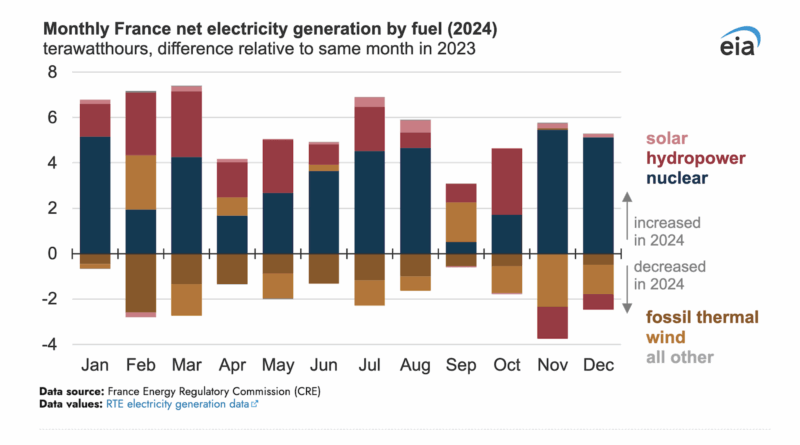France’s Increase in Nuclear & Hydropower in 2024 Led to More Electricity Exports

Last Updated on: 22nd July 2025, 02:08 am

In 2024, France increased its cross-border electricity deliveries by 48%, from 70 terawatthours (TWh) in 2023 to 103 TWh in 2024. France’s electricity exports to Belgium and Germany increased the most, but France also exported more electricity to Spain, Switzerland, the United Kingdom, and Italy, according to data from the European Network of Transmission System Operators for Electricity. Within France’s electricity generation mix, nuclear energy increased the most, followed by hydropower.
Overall, electricity generation in France increased by 45 TWh in 2024, while consumption remained relatively steady. Nuclear energy generation increased the most, followed by hydropower, while wind and natural gas-fired generation decreased.
The rise in French electricity generation reduced the country’s need for gross electricity imports, which fell by 50% in 2024. Among the six countries France imported electricity from in both 2023 and 2024, Spain was the largest source of electricity in both years. However, with France’s increased electricity generation and exports, Spain became a net importer of electricity from France, meaning it imported more electricity from France than they exported to France, similar to the other five countries that trade electricity with France.

Nuclear power is France’s leading source of electricity, accounting for nearly 65% of total electricity production in 2024, according to France’s Energy Regulatory Commission. France currently operates 57 nuclear reactors, the largest reactor fleet in Europe. Nuclear generation increased from 320 TWh in 2023 to 361 TWh in 2024, despite no change in installed nuclear capacity until Flamanville Unit 3 was added in December 2024, bringing nuclear generation more in line with historic output, according to data from nuclear operator EDF.
Nuclear power increased in 2024 as EDF addressed corrosion issues that affected nuclear generation beginning in 2021 and implemented a program designed to make maintenance outages at its reactors more efficient. The French government continues to consider nuclear power as part of its strategy to achieve carbon neutrality by 2050, which involves integrating nuclear power alongside renewable electricity technologies.
The second-largest source of power generation in France is hydropower, which increased from 58 TWh in 2023 to 75 TWh in 2024. By comparison, electricity generation from fossil sources decreased, from 32 TWh to 20 TWh. Wind power decreased from 51 TWh to 47 TWh.
Principal contributors: Katherine Antonio, Slade Johnson
Sign up for CleanTechnica's Weekly Substack for Zach and Scott's in-depth analyses and high level summaries, sign up for our daily newsletter, and follow us on Google News!
Have a tip for CleanTechnica? Want to advertise? Want to suggest a guest for our CleanTech Talk podcast? Contact us here.
Sign up for our daily newsletter for 15 new cleantech stories a day. Or sign up for our weekly one on top stories of the week if daily is too frequent.
CleanTechnica uses affiliate links. See our policy here.
CleanTechnica's Comment Policy

